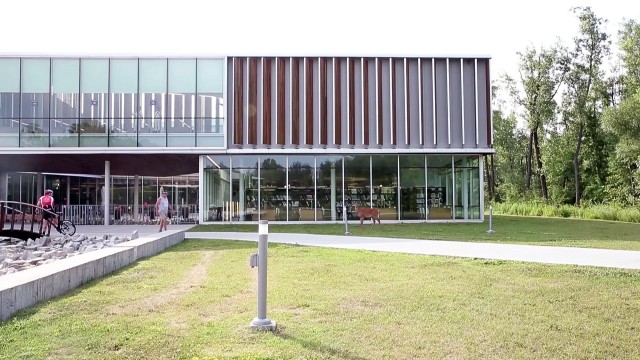Raymond-Lévesque Library
The City of Longueuil’s Raymond-Lévesque Library is the winning project by Atelier TAG + Jodoin Lamarre Pratte architectes of a competition held in 2008, and recipient of close to 20 awards and distinctions. The library is the fifth largest in Quebec and plays a primary role in the civic and cultural life of the community. It is a striking example of the integrated design method that results in an "art of building" process as developed by the consortium on many recent projects.
Location
Partners
Atelier TAG
Scale
4 000 m² / 11,7 M$
Completion
2008 — 2011
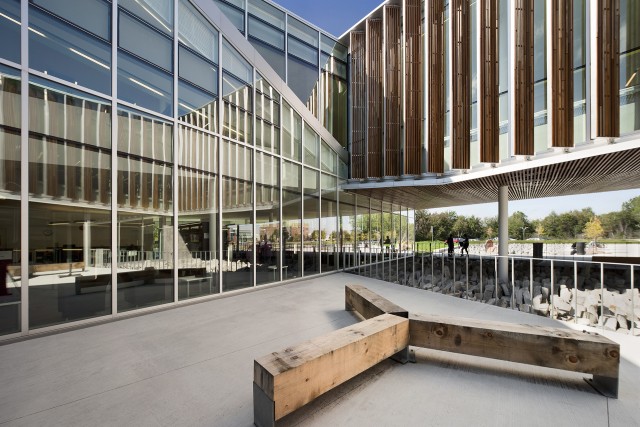
The main objectives at the origin of the concept were to rethink the traditional image of a public library, to pique the curiosity of visitors and users, to design an architecture specific to its site, to create a structure sculpted by the forces of nature, and to replace the forested area removed for the project with a building constructed in wood. Covering an area of 4,000 m², the project unfolds from the city to the forest and revolves around a playground that supports visual links and facilitates the orientation of users, while giving each space for reading, relaxing, and working its own intrinsic quality. Because of exceptional climatic conditions, the architectural concept implements award-winning, passive bioclimatic strategies focused on natural ventilation and lighting, placing the user at the centre of the notion of sustainable building. This project achieves 53% energy savings compared to the NECB (National Energy Code for Buildings) standard, and uses 40% renewable solar or geothermal energy.

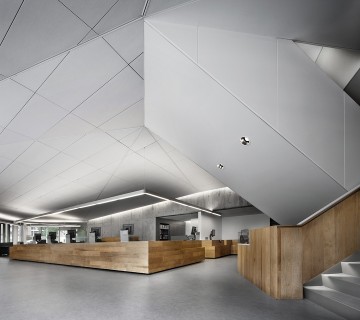
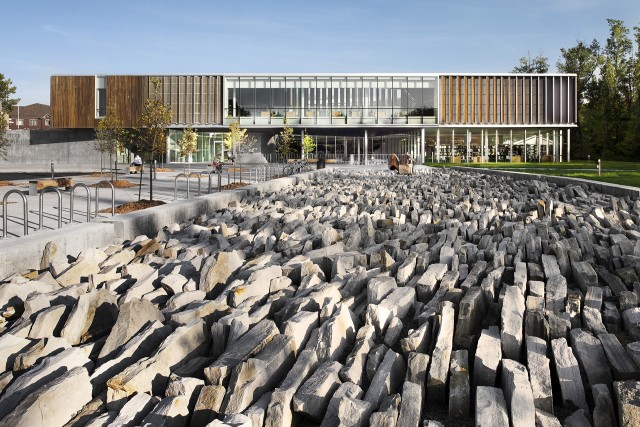
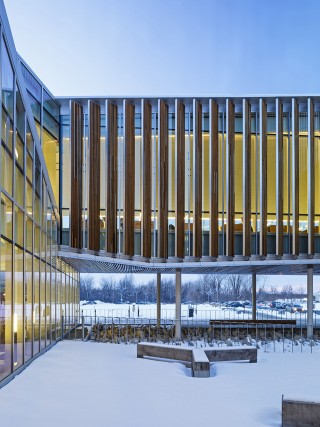
Due to its geographical location, the site benefits from unique weather conditions that offer remarkable wind energy potential. Recognized innovative energy saving and bioclimatic principles were implemented, placing the user at the centre of green design. The bioclimatic concept is based on the use of surrounding climatic resources: sun, water, wind, and soil (in geothermal energy). The project prioritizes solar energy in passive form (orientation, natural lighting) while avoiding a thermal gain during air-conditioning periods, among others, by choosing a high-performance glass. When solar resources are insufficient or if the cooling needs are greater than the cooling capacity of passive geothermal energy (underground supply duct), a geothermal field with a capacity of 150 kW provides over 70% of heating needs and 100% of cooling needs. A bold concept of motorized openings gives the building natural ventilation over a period covering nearly 50% of the library's opening hours. In addition to saving energy, this results in a special relationship with the surrounding parkland.
In winter, the snow that covers the inner courtyard reflects the light, naturally increasing the brightness of the glazed areas of the library. This fluidity with the landscape offers a temporal quality to the library with each season generating a unique and renewed experience of space.
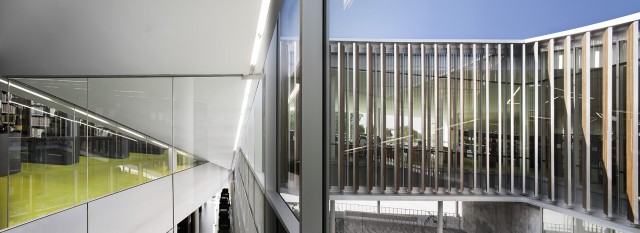
Building consumption statistics compared to the NECB reference building (National Energy Code for Buildings)
Overall energy consumption: - 53 %
Renewable solar and geothermal energy: + 40 %
Artifical lighting: - 17 % (30 000 kWh)
Water: - 40 %
Greenhouse gas emissions: - 120 tonnes
Waste recovery during construction: + 90 %
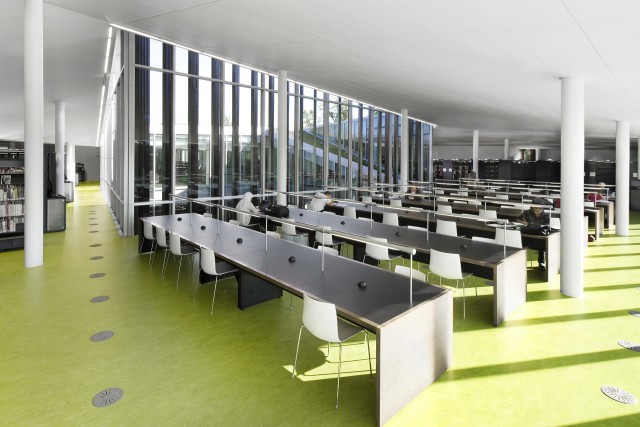
"The act of building a library in a community has great value in terms of symbolism, identity, and creativity. In Saint-Hubert, when the library was being constructed, we could finally dream of a place that reflects our vision of a gathering space—a kind of community centre—that serves as a place for the dissemination of knowledge.
The architecture of the site, its fenestration letting in an abundance of light and offering glimpses of a forested area changing with the rhythm of the seasons, encourages the citizen to spend time there. Disconnected from urban industries, citizens appropriate the place, which becomes a mainstay of the community and a meeting point. Although reading is an individual gesture, readers, in their need for gregariousness, like to gather around a common action in a tame environment which becomes a third living space."
Head of Library Services, City of Longueuil
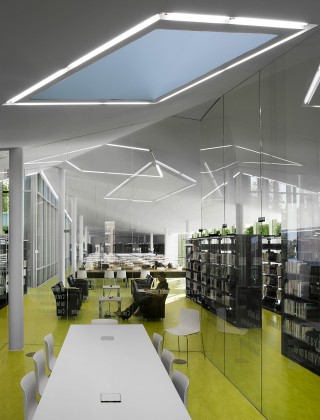
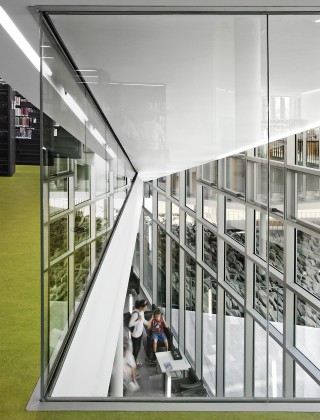
"Crossing the threshold of a beautiful library that meets the standards and requirements of the 21st century is always a pleasure for staff and the community. The Raymond-Lévesque Library quickly became part of the landscape and the pride of citizens. Seamlessly integrated into the Parc de la Cité, a conservation area for flora and fauna, the library is an important stop, as evidenced by attendance statistics that have quadrupled since its opening.
The most common comment is that the library is a bright building well integrated in the natural environment. The spaces are inviting, and the architects have responded to functional needs by offering patrons efficient and pleasant experiences. Raymond-Lévesque includes areas for watching films and listening to music, as well as a space for young people adapted for families with distinct sections for different age groups. All shelves and tables have a unique integrated lighting system that adds to the efficiency and ambience. The torrefied wood found outdoors was chosen for the interior staircase and integrated furnishings, adding warmth to the concrete and linoleum.
The library has become a gathering place, as the church square once was. After home and work, it is the "third space" for citizens. To achieve this, the library offers spaces encouraging exchange. In addition to the workrooms, patrons have embraced Café Dewey, the covered patio, and the Espace Presse where they can check their e-mail, watch the news, or read newspapers in paper or digital format. And finally, there is space to showcase the collection, space to read, relax, or learn in an immense reading room, not to mention the Météore reserved for teenagers, and the Espace-temps for passionate genealogy enthusiasts. The library is also a pleasant place to work with ergonomic, custom-made furniture, an appropriate arrangement of service and reader assistance counters, several areas for trolleys, a large delivery area, and a sorting room adapted for the 10,000 boxes received each year.
An inspiring library for librarians and architects who still come to visit two years after its opening to discover the examples of a successful balance between architecture and functionality."
Division Head, Raymond-Lévesque Library, Collection Development and Knowledge Transmission
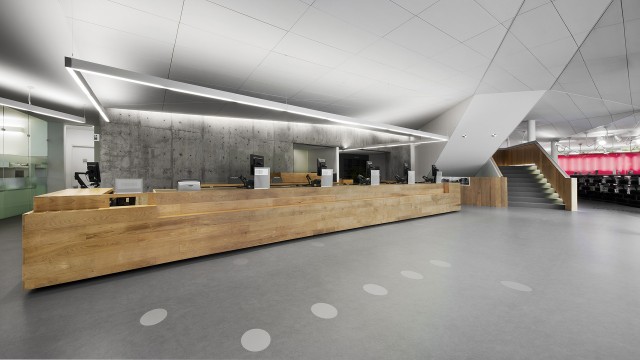
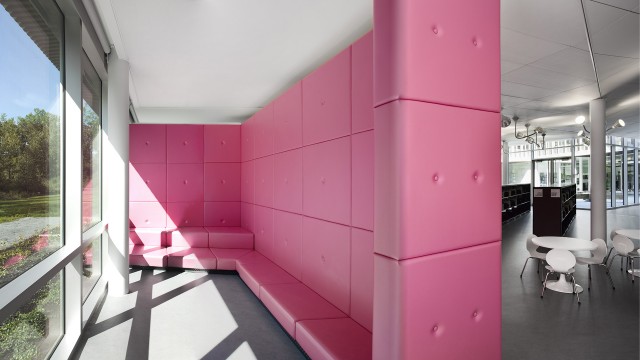
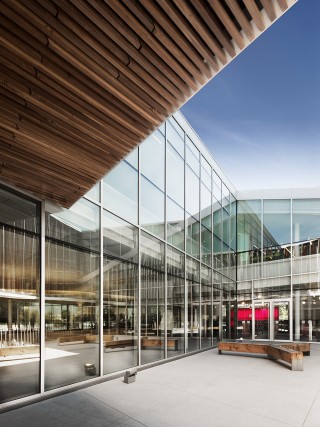
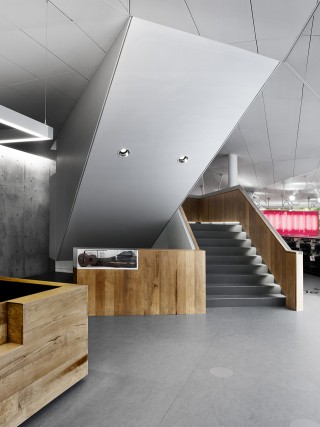
One year after its completion, the Raymond-Lévesque Library recorded a 200% increase in loans (335,000 in 2011 compared to 174,000 in 2010).
In addition, the library attracted an average of 650 people per day in 2011, compared with 250 in 2010.
